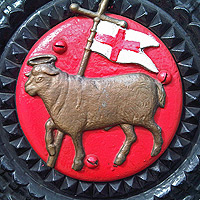In Search of The Lamb
The Lamb with and without a Flag
Comments of The Master of The Merchant Taylors Company
| A brief for the Master of The Merchant Taylors Company. Compiled by R H Adams. 1980 |
The quincentenary year of the first Grant of Arms to the Company has prompted me to compile these short notes about the Agnus Dei or Holy Lamb as Merchant Taylor insignia. The Lamb was introduced as a heraldic charge in 1481 and has since become our main emblem.
-
All the Gospels refer to John, the son of Zachariah, who, baptised Jesus and in the fourth Gospel he is called the herald of Christ - 'Behold, the Lamb of God' From this came the association in Christian art and iconography of the Lamb with St. John the Baptist. The metaphor of the shepherd and his sheep reflects the Jewish Passover and a Paschal Lamb was perpetuated as the emblem of St. John the Baptist, whom the tailors adopted as their patron saint.
-
The Holy Lamb was the symbolical representation of Christ from an early stage. Before this human person was depicted and first appeared in a Vatican cross in the sixth century, the figure of a Lamb carrying a cross and standing on a mount was the sign of Christ crucified. To the crozier was added a pennant or vexillum, hence the Lamb and Flag. There appears to be no definite authority in heraldic symbolism about the style and form of the Agnus Dei, and the two Lambs of the Company are but variations in the shape.
-
The blazon tif the first Grant of Arms on 20th October, 1481 details 'in a chief azure a holy lamb within the sun', but the painting of the College of Arms depicts a Lamb and Flag. The cross in this Grant of Arms is vertical.
-
The Corporate Seal of 1502 - the Company's oldest piece of silver - features St. John the Baptist wearing a camel hair robe and an outer cloak with a Lamb in his arms, resting on a book with a cross behind it. Beneath his feet is the shield of the 1481 Grant of Arms, clearly shewing a Lamb and Flag.
-
The Company's herse cloths, which both include in their design the first Grant of Arms, display scenes from the life of St. John the Baptist. Both give prominence to the Lamb and Flag.
-
In the second Grant of Arms (1586) the blazon reads 'on a green mound a lamb silver in the sun' The word 'holy' has disappeared in line with the new Protestant thinking. The Lamb is still drawn 'passant' (walking), but the Flag has disappeared. The less objectionable Lamb is transferred to a new position in the crest of the Arms to replace the Virgin and Child, which was symbolic of the old religion. From this date therefore the correct emblem of the Company is a Lamb in glory.
-

Device from the Inns of Court,
Middle Temple Lane
Embankment end - on the gates.Yet the Flag frequently appears after 1586. Surprisingly an authoritative drawing - in 'London's Armory' by Richard Wallis in 1677 depicts the Flag in the form of a cross with a streamer held in the left fore leg of the Lamb, which has a much longer body than that in the present drawing of the crest, from which the mound has disappeared. The error is not eliminated from representation of the arms on some of the Company's plate and china and on the outside of some of its publications until the beginning of this century. The cross in these examples is carried at an oblique angle.
-
Two institutions closely connected with the Company, an Oxford College and a public school, were founded before the second Grant of Arms. It could be argued that they could claim that the device of a Lamb and Flag can still be properly theirs.
(a) In 1555 Sir Thomas White,-Master in 1535 and Lord Mayor in 1553, founded in the tradition of the old religion a college at Oxford which was to bear the name of St. John the Baptist, from the obvious connection with the Company's patron saint. The Lamb and Flag, although not incorporated in its achievement, still provides its emblem and gives the name to the College boat. The deeds of an adjoining property to the north record that in 1617 the house was called The Lamb. Under the signboard of the Lamb and Flag it is now a well-known inn.
(b) The Company's school, which was founded six years later, likewise preceded the second Grant of Arms. Within living memory the cap worn by its scholars bore the badge of the Lamb and Flag. Until the removal from Charterhouse Square to Northwood, this was the insignia of the school as distinct from the Company. It is still the device of the Old Merchant Taylors' Society. -
The Company is peculiar in having a Lamb without a Flag. The Lamb of the Middle Temple, that of the Queen's Royal West Surrey Regiment (Second foot and 'Kirke's Lambs') and that of the Borough of Lambeth, each carries a Flag.
-
Perhaps the College of Arms might comment more definitively on the changes in style.
Related Links
